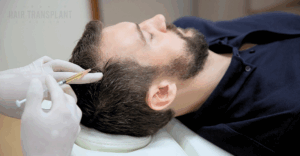Transcript From TSN RADIO SHOW – THE OVERDRIVE
Jeff:
Last week, we had somewhat of a revelation on this show. I think it was last week, maybe two weeks ago. Who knows?
Jamie:
Well, I had a traumatic situation. That’s basically what happened, and I had to come clean and tell you guys. During this break, I don’t know if the stress or something has happened, but I saw a horrifying picture where I was bathing my son and Steph walked by and snapped a photo, and it looks like you, Hayes, on the 11th hole, where you’ve chunked one off, and there’s a hole in the back of my head.
Jeff:
Yeah, there’s a pelt. There’s a pelt. Someone hit a 56-degree sand-wedge and took half the planet with it, and that’s what happened at the top of your head.
O:
Yeah, and it’s like you hit three inches behind the ball and you followed it right though to the hole.
Jamie:
In defensive of all of this, Steph said it’s bad lighting because we’ve taken pictures since then …
O:
Bad lighting, my ass.
Jeff:
Okay, let’s get the doc on here. You know what that reminds me of? It’s Frank Costanza, where it’s, “One in a million, doc. You wouldn’t believe it, one in a million.” I’ll bet you everyone comes in there and goes, “I think my hair is fine, but bad lighting in my house.”
Jamie:
Exactly.
Jeff:
So I just want to clarify here. He is Dr. Rob Jones, hair transplant doctor right here in Toronto. Dr. Rob, thank you for joining us.
Dr. Rob Jones:
Oh, it’s a pleasure Jeff, yeah. Fun to be here.
Jeff:
This is a great pleasure of ours to have you on the show. How often do you guys walk in and say, “I think I might be thinning, but there’s a chance that it’s just bad lighting in the house?”
Dr. Rob Jones:
Well, we take photos of every patient that comes in and we do photos for the chart, and I print the photos up and give them to the patient. Most of the time they say to me, “That’s not me. It can’t be.” They look at the pictures and they blame the lighting, they blame the camera. I say, “Listen, this is just the way it is.”
Dr. Rob Jones:
And most of the time, guys don’t get a photo taken of the back of their head, so they aren’t aware of how it’s progressing. And when they see it, it’s difficult for them to believe, but the way it is, pretty well every guy on the planet has less hair this year than they did last year, and it’s just the way it’s going. Unless you do something about it, that’s just the way it is.
Jeff:
Well, that’s where you come into play here.
Jamie:
Yeah. I mean, this is the thing. So our producer, I believe, text you a picture of what I’ve got going on, on the back of my head, the horrifying picture that I saw. From your just professional analysis right now, where am I headed? Where is this mess headed? What direction am I heading in?
Dr. Rob Jones:
Well, everybody’s heading in the same direction. They’re going to have less hair in a few years than they have now, if you do nothing about it, but there’s definitely options. I mean, in the year 2020, going bald is an option. You don’t have to. Just take a look at Elon Musk or Matthew McConaughey, Jude Law, all those guys, they have a lot more hair now than they did several years ago, and the reason for that is because they did something about it and there’s lots of options. So there’s no reason why you can’t have the same or more hair in five or 10 years than you do now, but there’s just a few things you have to do to be proactive.
Jeff:
Wow. Treatment plan for [crosstalk 00:03:29].
O:
Doc, what I want to know is … I’ll legit come see you, because I just want some preventative measure. I think I got a solid head of hair right now, there’s just a couple spots you could do-
Dr. Rob Jones:
Yeah, the sooner the better, really. I mean, the sooner you do something about it … It’s easier to preserve what you have than if you’re dealing with a George Costanza, it’s, just throw your hands in the air.
O:
What I want to know though is, I want realistic stuff, because I can spot a carpet from a mile away. So when I get it done, I want it to be natural, it looks like my own hair and Bob’s your uncle, done.
Dr. Rob Jones:
I’ve had it done, and if you come through the door and you look at me and say that I don’t like the looks of that hair transplant, I can show you my before photos. They were worse than yours, and I could show you my hair now, and anyone that looked at me would think I had almost a full head of hair. It’s not as thick as it was when I was 20 or 25 years old. So I mean, if it’s done properly and done in conjunction with treatments, you could have all your hair back and it’ll look 100% natural.
Jeff:
I’m looking at a pic of you right now. You have a salad going, Dr. Rob.
Jamie:
Yeah, glorious.
Jeff:
Yes.
Jamie:
Gorgeous hair.
Jeff:
Glorious flow.
Dr. Rob Jones:
I wish you had a copy of my before photos, but I have a lot less hair.
Jeff:
Yeah.
Jamie:
I’ve got a question. So because you do that for a living, do you walk around and be like, “That’s a bad job, that guy.” Would you be able to spot a guy like Andre Agassi who lied to all of us, where he was bald and he said he wore a wig? Can you walk around in everyday life and be like-
Dr. Rob Jones:
A mile away, I can spot it. I can spot it. When I’m out and about, I’m always looking at hairlines. That’s my job.
Jeff:
Okay.
Dr. Rob Jones:
And you can tell a mile away, and you guys can tell too. I mean, you can tell.
Jeff:
Oh yeah.
Dr. Rob Jones:
Yeah.
Jamie:
Well, I couldn’t tell. Until about a month ago, I thought I was doing pretty good, but I’ve never looked at the back of my head. Now, all of a sudden, I’m traumatized and I’ve got to do some preventative measures here. O has been talking about a treatment that he’s heard in San Diego where you go down there for, what is it O, a month or something? You wear a helmet for a month.
O:
Yeah. Well, you get the treatment done. I think it’s for serious cases like yourself, Jamie, but you got to wear a full helmet afterwards. Is that something, doc?
Jamie:
Do I have to wear a helmet?
Dr. Rob Jones:
You got to be really careful. There’s going to be a thousand different treatments out there that are not proven and not FDA approved. And you got to be very careful just to make sure that when you go for a treatment, that you’re going for something that actually is going to make a difference and work. And I mean, all I do is I read about hair treatments, and I don’t think I’ve ever heard of anything that you wear a helmet for a month. I mean, that sounds like a pretty weird thing.
O:
Okay, well, I’m going to talk to the guy that brought it to my attention.
Dr. Rob Jones:
Yeah, I’m actually going to do a search tonight for it: San Diego helmet for a month.
Jamie:
Okay, so give us a story of like, I’m sure you’ve had all type of characters walk through your door. Has there been some form of crazy request where you’ve said, “You know what? Hold on one second,” and you’ve had to leave the room to compose yourself to go back and deal with this character?
Dr. Rob Jones:
It’s funny. I had a feeling you were going to ask me that, but I think some of the stories, it wouldn’t be really fit to tell on the radio.
Jamie:
Fair enough.
Dr. Rob Jones:
Yeah. Maybe over a beer sometime, but not on the radio for sure. But definitely, I’ve put hair from everywhere and put it to everywhere. I mean, with current techniques, the way we do it is we actually pluck the hairs out one at a time and move them from one location to another. So there’s no way you could tell from the donor site or the recipient site.
Dr. Rob Jones:
So you can take hairs from the beard or the chest or really anywhere on the body, and move it to a different location. So with the punches that we have, they’re small enough, they don’t leave a scar on the donor site, and then we put them into needle holes on the recipient site, so nothing is left on the recipient site. You can’t see anything in the recipient site either.
Dr. Rob Jones:
So I’ve definitely moved lots on lots of patients, moved hair from their head to their chest and from the chest to the head. The old transplants, they used to make an incision in the back, left a linear scar, and so I’ve taken body hair, chest hair or underarm hair and put it into those scars on the back of their head. So I mean, we take hair from everywhere and put it everywhere. So you can imagine, there’s a variety of patients that we see because of that, just with different requests.
Jeff:
He is Dr. Rob Jones, hair transplant doctor. We’ll leave it there. Look into the helmet treatment. I think it may be revolutionary. I think we should bring it to Toronto. I think there’s a lot of people that are interested in that.
O:
And I’ll come and see you.
Dr. Rob Jones:
It’s been good talking to you guys.
O:
I’m coming to see you for sure.
Jamie:
Yeah, we’ve got to come in and see you for sure.
Dr. Rob Jones:
You’ve got my cell phone number. Just send me a text and we’ll … No problem.
Jeff:
You got it. Thank you for doing this. Appreciate it.
O:
Thanks, doc.
Dr. Rob Jones:
Okay.
Jamie:
Thanks, Dr. Rob.
Jeff:
There he is. Dr. Rob Jones, with the full breakdown.
Jamie:
I mean, you know what we should do is have a GoFundMe page and maybe we can get Struddy some treatment. A guy like Caber or Struddy.
Jeff:
Struddy or Caber, yeah. Yeah, I think that’s probably worthy of looking into. There’s a lot of charitable people out there and I think that’s something we need to look into. We got to get to the bottom of the whole helmet thing for a month though too.
Jamie:
I think that’s fake news.
Jeff:
I guess, but I’ve heard of that guy down in San Diego. I’ve heard a lot about him.






